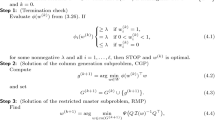Abstract
In this paper we will discuss the application of observability to the planning of sensor configurations in numerical weather prediction (NWP). The dimensions used in NWP make conventional definitions of observability impractical. For this reason we will rely partial observability which is obtained using dynamic optimization to approximate the observability. Using this metric we will form an optimization problem to select sensor configurations that maximize the partial observability of the dynamical system. This leads to a max–min problem which using an empirical gramian matrix we reduce to an eigenvalue optimization problem. Atmospheric data assimilation is the process of combining prior knowledge with observations to form an estimate of the system state required to produce a forecast of future weather conditions. Optimal sensor configurations leading to improved forecast quality are of interest. Due to the potential size of our intended application we will focus on computational methods that are both efficient and scalable. We will also leverage existing tools used in data assimilation and introduce tools used in nonsmooth optimization.





Similar content being viewed by others
References
Baker N, Daley R (2000) Observation and background adjoint sensitivity in the adaptive observation-targeting problem. Q J R Meteorol Soc 126:1431–1454
Langland R, Baker N (2004) Estimation of observation impact using the NRL atmospheric variational data assimilation adjoint system. Tellus 56A:189–201
Gelaro R, Langland R, Pellerin S, Todling R (2010) The THORPEX observation intercomparison experiment. Mon Weather Rev 138:4009–4025
Kang W, Xu L (2009) Computational analysis of control systems using dynamic optimization. arXiv:0906.0215v2
Xu L, Rosmond T, Daley R (2005) Development of NAVDAS-AR: formulation and initial tests of the linear problem. Tellus 57A:546–559
Kang W, Xu L (2009) A quantitative measure of observability and controllability. In: Proceedings of the IEEE conference on decision and control, Shanghai
Kang W (2011) The consistency of partial observability for PDEs. arXiv:1111.5846.
King SA, Kang W, Xu L (2013) Partial observability for the shallow water equations. In: Proceedings of SIAM conference on control & its applications, San Diego
Morales JL, Nocedal J (2011) L-BFGS-B: remark on algorithm 778: L-BFGS-B, FORTRAN routines for large scale bound constrained optimization. ACM Trans Math Softw 38
Lewis AS, Overton ML (2012) Nonsmooth optimization via quasi-Newton methods. Math Program 141:135–163
Kang W, Xu L (2012) Optimal sensor placement for data assimilations. Tellus 64A:17133
Rosmond T (1997) A technical description of the NRL adjoint modeling system. Naval Research Laboratory Publication, Monterey
Houghton DD, Kasahara A (1968) Nonlinear shallow fluid over an isolated ridge. Commun Pure Appl Math 21:1–23
Lawless A (2001) Irrotational shallow water model (Version 0.1) [Computer Software]. National Center for Earth Observation, Reading
Johnson C, Hoskins B, Nichols N (2005) A singular vector perspective of 4D-Var: filtering and interpolation. Q J R Meteorol Soc 131:1–19
Author information
Authors and Affiliations
Corresponding author
Rights and permissions
About this article
Cite this article
King, S., Kang, W. & Xu, L. Observability for optimal sensor locations in data assimilation. Int. J. Dynam. Control 3, 416–424 (2015). https://doi.org/10.1007/s40435-014-0120-7
Received:
Revised:
Accepted:
Published:
Issue Date:
DOI: https://doi.org/10.1007/s40435-014-0120-7




